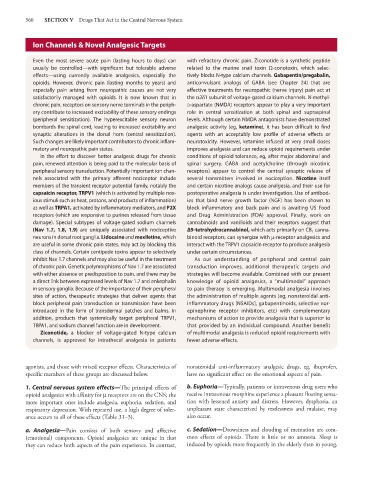Page 574 - Basic _ Clinical Pharmacology ( PDFDrive )
P. 574
560 SECTION V Drugs That Act in the Central Nervous System
Ion Channels & Novel Analgesic Targets
Even the most severe acute pain (lasting hours to days) can with refractory chronic pain. Ziconotide is a synthetic peptide
usually be controlled—with significant but tolerable adverse related to the marine snail toxin Ω-conotoxin, which selec-
effects—using currently available analgesics, especially the tively blocks N-type calcium channels. Gabapentin/pregabalin,
opioids. However, chronic pain (lasting months to years) and anticonvulsant analogs of GABA (see Chapter 24) that are
especially pain arising from neuropathic causes are not very effective treatments for neuropathic (nerve injury) pain act at
satisfactorily managed with opioids. It is now known that in the α2δ1 subunit of voltage-gated calcium channels. N-methyl-
chronic pain, receptors on sensory nerve terminals in the periph- d-aspartate (NMDA) receptors appear to play a very important
ery contribute to increased excitability of these sensory endings role in central sensitization at both spinal and supraspinal
(peripheral sensitization). The hyperexcitable sensory neuron levels. Although certain NMDA antagonists have demonstrated
bombards the spinal cord, leading to increased excitability and analgesic activity (eg, ketamine), it has been difficult to find
synaptic alterations in the dorsal horn (central sensitization). agents with an acceptably low profile of adverse effects or
Such changes are likely important contributors to chronic inflam- neurotoxicity. However, ketamine infused at very small doses
matory and neuropathic pain states. improves analgesia and can reduce opioid requirements under
In the effort to discover better analgesic drugs for chronic conditions of opioid tolerance, eg, after major abdominal and
pain, renewed attention is being paid to the molecular basis of spinal surgery. GABA and acetylcholine (through nicotinic
peripheral sensory transduction. Potentially important ion chan- receptors) appear to control the central synaptic release of
nels associated with the primary afferent nociceptor include several transmitters involved in nociception. Nicotine itself
members of the transient receptor potential family, notably the and certain nicotine analogs cause analgesia, and their use for
capsaicin receptor, TRPV1 (which is activated by multiple nox- postoperative analgesia is under investigation. Use of antibod-
ious stimuli such as heat, protons, and products of inflammation) ies that bind nerve growth factor (NGF) has been shown to
as well as TRPA1, activated by inflammatory mediators, and P2X block inflammatory and back pain and is awaiting US Food
receptors (which are responsive to purines released from tissue and Drug Administration (FDA) approval. Finally, work on
damage). Special subtypes of voltage-gated sodium channels cannabinoids and vanilloids and their receptors suggest that
(Nav 1.7, 1.8, 1.9) are uniquely associated with nociceptive Δ9-tetrahydrocannabinol, which acts primarily on CB 1 canna-
neurons in dorsal root ganglia. Lidocaine and mexiletine, which binoid receptors, can synergize with μ-receptor analgesics and
are useful in some chronic pain states, may act by blocking this interact with the TRPV1 capsaicin receptor to produce analgesia
class of channels. Certain centipede toxins appear to selectively under certain circumstances.
inhibit Nav 1.7 channels and may also be useful in the treatment As our understanding of peripheral and central pain
of chronic pain. Genetic polymorphisms of Nav 1.7 are associated transduction improves, additional therapeutic targets and
with either absence or predisposition to pain, and there may be strategies will become available. Combined with our present
a direct link between expressed levels of Nav 1.7 and enkephalin knowledge of opioid analgesics, a “multimodal” approach
in sensory ganglia. Because of the importance of their peripheral to pain therapy is emerging. Multimodal analgesia involves
sites of action, therapeutic strategies that deliver agents that the administration of multiple agents (eg, nonsteroidal anti-
block peripheral pain transduction or transmission have been inflammatory drugs [NSAIDs], gabapentinoids, selective nor-
introduced in the form of transdermal patches and balms. In epinephrine receptor inhibitors, etc) with complementary
addition, products that systemically target peripheral TRPV1, mechanisms of action to provide analgesia that is superior to
TRPA1, and sodium channel function are in development. that provided by an individual compound. Another benefit
Ziconotide, a blocker of voltage-gated N-type calcium of multimodal analgesia is reduced opioid requirements with
channels, is approved for intrathecal analgesia in patients fewer adverse effects.
agonists, and those with mixed receptor effects. Characteristics of nonsteroidal anti-inflammatory analgesic drugs, eg, ibuprofen,
specific members of these groups are discussed below. have no significant effect on the emotional aspects of pain.
1. Central nervous system effects—The principal effects of b. Euphoria—Typically, patients or intravenous drug users who
opioid analgesics with affinity for μ receptors are on the CNS; the receive intravenous morphine experience a pleasant floating sensa-
more important ones include analgesia, euphoria, sedation, and tion with lessened anxiety and distress. However, dysphoria, an
respiratory depression. With repeated use, a high degree of toler- unpleasant state characterized by restlessness and malaise, may
ance occurs to all of these effects (Table 31–3). also occur.
a. Analgesia—Pain consists of both sensory and affective c. Sedation—Drowsiness and clouding of mentation are com-
(emotional) components. Opioid analgesics are unique in that mon effects of opioids. There is little or no amnesia. Sleep is
they can reduce both aspects of the pain experience. In contrast, induced by opioids more frequently in the elderly than in young,

